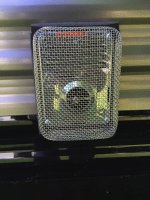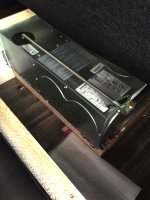Hi Heartland Owners Forum - first post for me!
I have a 2016 Heartland Runner 25 SLE travel trailer. I’m having an issue with rain water leaking into the unit from the furnace (Atwood) area.
To me, it seemed that the water was getting into the unit from the furnace exterior vent. I spoke to my Dad (jbeletti) about it and he suggested I speak with Atwood directly to see if they felt rain water could get into the the exterior vent. I described the situation to Atwood and they felt that rain water could enter the vent with heavy rain. I asked them if they felt the furnace vent was installed improperly and from what I described to them, they felt it was installed properly.
We’re not using the furnace at this time and for now, I’ve wrapped the vent with plastic to prevent water entry. We’ve had a LOT of rain lately - and no water has been noted inside the unit. So I’m pretty sure, regardless of what Atwood felt, that my furnace may not have been properly installed. I’m unsure as to what the proper process is but I’ll probably contact Heartland Customer Service about it this week.
The Trail Runner is a stick and tin unit. As such, the exterior siding is ribbed aluminum. This means that there isn’t a flat surface for exterior items to seal tight against. I guess gaskets and sealants is the key here.
Would anyone be willing to hazard a guess as to why water enters the unit, seemingly through the furnace vent? I’m attaching a couple of pictures I took. Two are exterior and one shows a paper towel on the floor behind the furnace. The paper towel is absorbing water that seems to come from “underneath” the furnace. To my knowledge, water is not coming into the unit from within the furnace, but perhaps around the furnace.



Thanks.
I have a 2016 Heartland Runner 25 SLE travel trailer. I’m having an issue with rain water leaking into the unit from the furnace (Atwood) area.
To me, it seemed that the water was getting into the unit from the furnace exterior vent. I spoke to my Dad (jbeletti) about it and he suggested I speak with Atwood directly to see if they felt rain water could get into the the exterior vent. I described the situation to Atwood and they felt that rain water could enter the vent with heavy rain. I asked them if they felt the furnace vent was installed improperly and from what I described to them, they felt it was installed properly.
We’re not using the furnace at this time and for now, I’ve wrapped the vent with plastic to prevent water entry. We’ve had a LOT of rain lately - and no water has been noted inside the unit. So I’m pretty sure, regardless of what Atwood felt, that my furnace may not have been properly installed. I’m unsure as to what the proper process is but I’ll probably contact Heartland Customer Service about it this week.
The Trail Runner is a stick and tin unit. As such, the exterior siding is ribbed aluminum. This means that there isn’t a flat surface for exterior items to seal tight against. I guess gaskets and sealants is the key here.
Would anyone be willing to hazard a guess as to why water enters the unit, seemingly through the furnace vent? I’m attaching a couple of pictures I took. Two are exterior and one shows a paper towel on the floor behind the furnace. The paper towel is absorbing water that seems to come from “underneath” the furnace. To my knowledge, water is not coming into the unit from within the furnace, but perhaps around the furnace.



Thanks.
